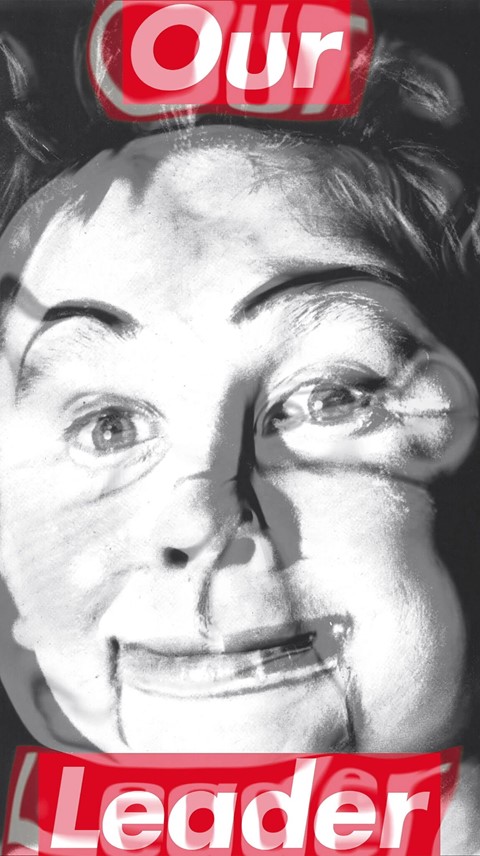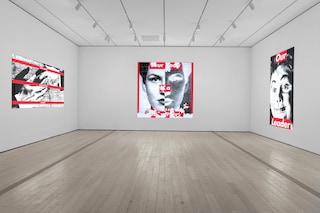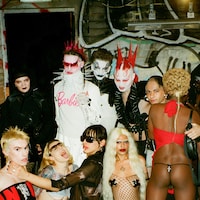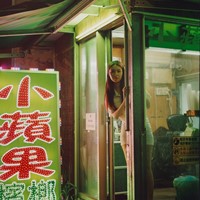As her major exhibition THINKING OF YOU. I MEAN ME. I MEAN YOU. opens at Serpentine, we draw on Kruger’s own quotes to explore her extraordinary life and legacy
Barbara Kruger came to prominence in the 1980s when she began making boldly graphic art juxtaposing striking images with provocative, declarative statements in what would become her signature aesthetic (white-on-red Helvetica and Futura fonts). If her work reminds you of propaganda, that’s because it is: it’s propaganda for anti-consumerism, for women’s rights, for equality, and for thinking.
Kruger learned her craft working as a graphic designer in magazines in the mid-to-late-1960s, where she grasped the imperative and the technique of engaging the viewer with arresting visuals. Her artwork employs the visual language of branding and advertising to condemn consumer culture and to critique constructs of power, identity, and gender, to promote thought and generate discourse.
Notoriously media-averse and aloof from the celebrity trappings of the art world, Kruger has consistently continued to use her artwork to speak back to power. THINKING OF YOU. I MEAN ME. I MEAN YOU. – her first London solo institutional exhibition in over 20 years – opens at Serpentine and promises to ‘go beyond the gallery walls’ in a series of outside banners and electric taxis, large-scale, immersive wraparound screens at Outernet Arts [opening on March 4, 2024] and a unique Barbara Kruger TikTok effect. As the major exhibition opens its doors, we take a look at Kruger’s life and work through the artist’s own words.
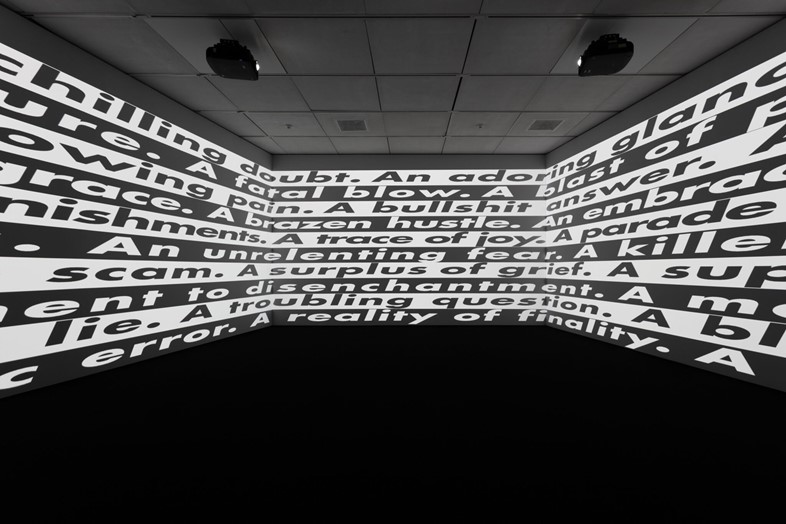
“I had difficulty in supplying someone else’s image of perfection.”
Kruger’s life and her practice as an artist have been shaped by resistance and refusal. Studying art and design in the mid-1960s at Parsons School of Design in New York under the acclaimed photographer Diane Arbus, Kruger told Dazed, “She was the first female role model I had that didn’t wash the kitchen floor six times a day.” After college, Kruger was taken on as a designer at Condé Nast Publications, where she excelled in the role and was promoted to head designer that following year. Despite her early success, working to someone else’s brief was too much of a compromise. "I basically wasn't cut out for design work,” she said. “Because I had difficulty in supplying someone else’s image of perfection."
Kruger eventually moved on to working as a picture editor for various publications and, during this time, began writing poetry and attending poetry readings (where, incidentally, she was once introduced to the stage by Patti Smith). She also began making art. Her experiments saw her crocheting erotic objects and creating wall hangings from various materials including yams, feathers, and sequins. In 1976 Kruger relocated to Berkley, where she began teaching at the University of California and immersed herself in theoretical texts – including, significantly, Roland Barthes, whose work explored design theory, semiotics, and the “sign systems” functioning in popular culture. All these phases and interests may have seemed disparate, but she was forming a constellation of experience that would, ultimately, inform her artistic methodology and her distinctive visual style.
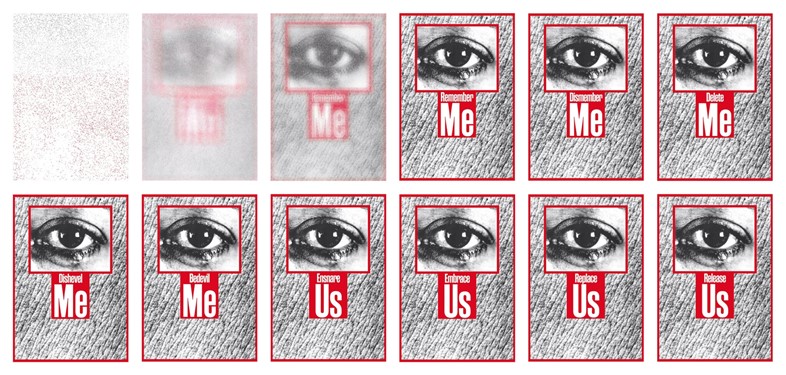
“It was all about how you create arresting works, and by arresting I mean stop people, even for a nano-second.”
Kruger's work as a designer provided her with a wealth of transferable skills. “Everything was cut and paste and I would do a page design involving type and sometimes images. My job as a designer morphed into my work as an artist, with big differences in the level of meaning.“ She told The National Gallery of Art. “When I first started making this series of works, they were done as paste-ups similar to what I would do at the magazine.” She used the conventions of advertising and mass-communication but, rather than selling a product, she used these techniques to promote a kind of questioning, encouraging the viewer to interrogate ideas that might have previously seemed self-evident.
Kruger’s graphic design background also primed her in the art of engaging immediately with the viewer. “One thing I learned working at magazines was that if you couldn’t get people to look at a page or a cover, then you were fired,” she recalled. “It was all about how you create arresting works, and by arresting I mean stop people, even for a nano-second.” She understood, even before the advent of social media, that people had so little capacity to focus. Her work evolved to capture people’s attention, not just in the immediacy of the images she chose, but in the pithy, direct phrases she employed. “Do you know why language manifests itself the way it does in my work?” she asked. “It's because I understand short attention spans.”
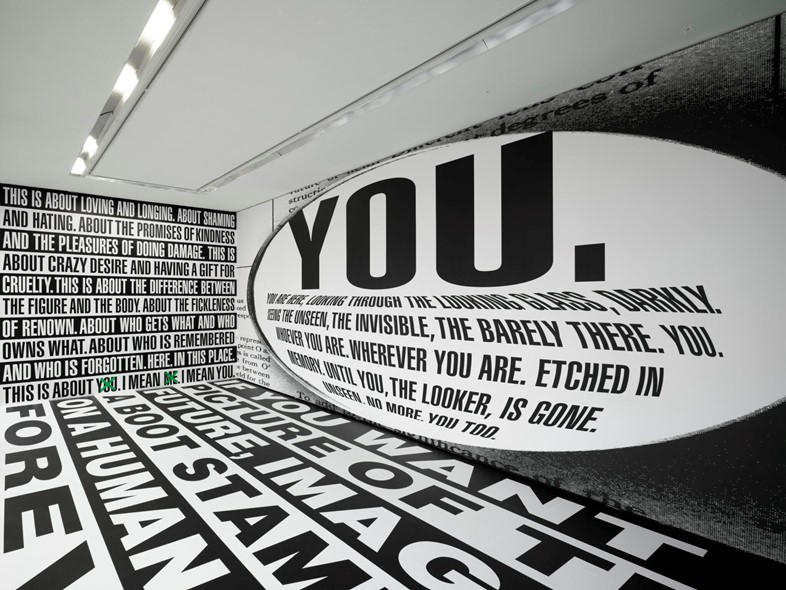
“‘Women’s art’, ‘political art’ — those categorisations perpetuate a certain kind of marginality which I’m resistant to. But I absolutely define myself as a feminist.”
Throughout her career, Kruger has struggled against being pigeonholed in any way. She has insisted, “I'm not crazy about categories.” Among the first of her works to gain notoriety were the billboards challenging internalised misogyny and women’s reproductive freedom, emblazoned with statements such as: “Your gaze hits the side of my face”, “Your body is a battleground”, and “I shop therefore I am”. Despite the overt feminist sentiment of these works and the fact that she absolutely defines herself as a feminist, Kruger has always resisted definitions when it comes to her art, saying, “‘Women’s art’, ‘political art’ – those categorisations perpetuate a certain kind of marginality which I’m resistant to." There’s a potential danger in banner-waving and labelling. Does the term “women’s art” suggest that all other art isn’t for women? Does this kind of catagorisation potentially reinforce the boundaries of exclusion and reiterate the notion of what is and isn’t permissible in particular areas of culture and life?
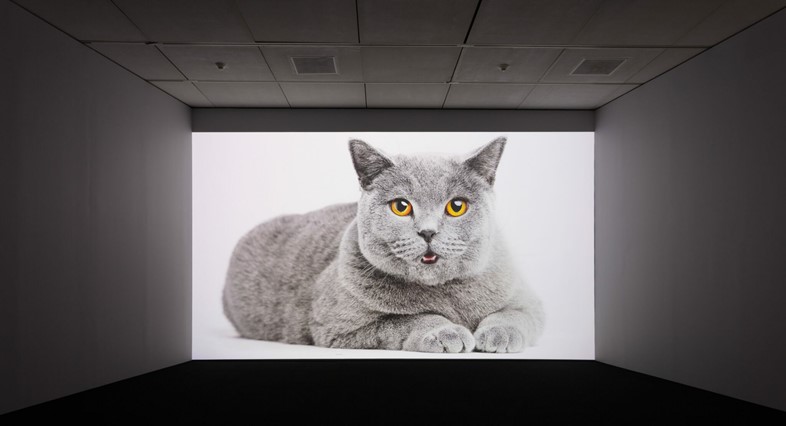
“I think what I’m trying to do is create moments of recognition. To try to detonate some kind of feeling or understanding of lived experience”
Despite having been shown in some of the most prestigious museums and galleries in the world, Kruger’s art is arguably at its most potent when exhibited in non-traditional art spaces, such as the facades of public buildings, billboards, on public transport, and consumer goods.
Memorable projects Kruger made specifically for the public domain include her 1984 t-shirt collaboration with fashion designer Willi Smith for his label WilliWear Productions. It featured an editorial-looking image of a woman’s face with the lovelorn – or possibly menacing – phrase “I can’t look at you… and breathe at the same time” obscuring her eyes and mouth. “L'empathie peut changer le monde” (1994), installed on a train station platform in Strasbourg in France, reminds train users, “Empathy can change the world.” The iconic “Untitled (Questions)” (first commissioned in 1990 but reinstalled in 2018) is a vast mural on the side of the the Geffen Contemporary at Museum of Contemporary Art in LA, posing a series of questions that Los Angeles Times described as “both oblique and direct”. Passers-by are confronted with, “WHO IS BEYOND THE LAW? WHO IS BOUGHT AND SOLD? WHO IS FREE TO CHOOSE? WHO DOES TIME? WHO FOLLOWS ORDERS? WHO SALUTES LONGEST? WHO PRAYS LOUDEST? WHO DIES FIRST? WHO LAUGHS LAST?” Commissioned to make work for a public awareness campaign promoting arts instruction in the Los Angeles Unified School District, Kruger once again covered a bus with text, including wisdom such as “GIVE YOUR BRAIN AS MUCH ATTENTION AS YOU DO YOUR HAIR AND YOU’LL BE A THOUSAND TIMES BETTER OFF”.
The benefit is two-fold: the work is seen and interacted with by vastly greater numbers of people when, for instance, it’s emblazoned on a huge billboard on a boulevard in LA. But also, outside the sanctioned domain of the exhibition space, Kruger’s artwork takes on an even more provocative and complex resonance. We enter a gallery hoping to be moved or challenged in some way; we are ready and willing for our consciousness to be expanded. But we don’t necessarily expect to encounter fiercely anti-capitalist rhetoric when we’re making our way to the mall or see a billboard that makes you consider whether or not you’ve internalised any of the misogyny you’ve experienced during the course of your life. “I think what I'm trying to do is create moments of recognition,” she once said. “To try to detonate some kind of feeling or understanding of lived experience.” And these sparks of perception are perhaps more powerful when they rouse us roughly out of our own self-absorption or general complacency; catching us by surprise by inhabiting spaces we don’t expect to be challenged or flashing past on the side of a bus when we’re crossing the road.
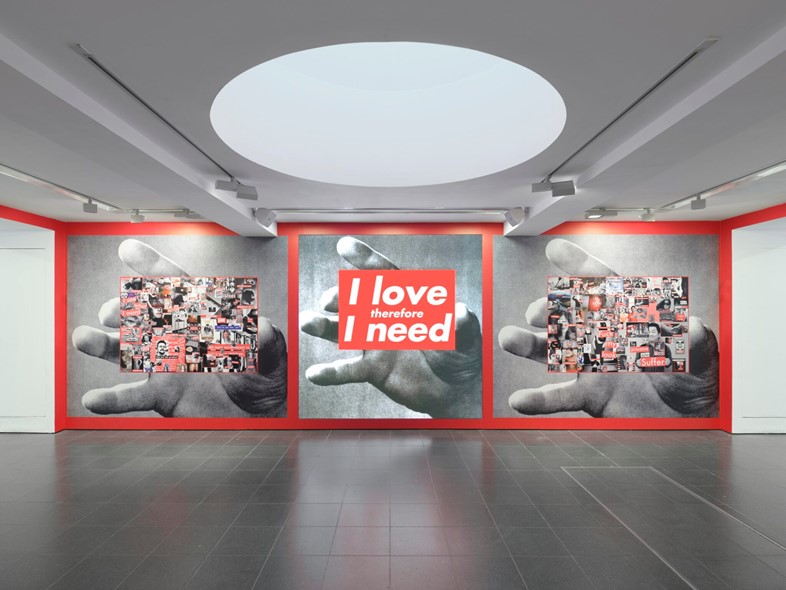
“Unfortunately I do have to sometimes show up to my own openings and dinners, though I’d rather go to hell.”
In 2011, in a perfect satire of capitalism and the art market, Kruger’s iconic “Untitled (When I hear the word culture I take out my checkbook)” (1985) sold at auction for $902,500. But, despite her economic and critical success, Kruger has always tried to stay as aloof as possible from the art establishment and her own reputation as an artist. She told Artnet, “It never ceases to surprise me that people know my name and my work. It’s very thrilling that it played out this way, but the art subcultures are very arbitrary and brutal and fickle, and I try not to take myself, or it, too seriously.”
As an emerging artist, she’d felt intimidated to enter New York galleries, sensing an unwelcome atmosphere that seemed hostile to women, “particularly independent, non-masochistic women” she recalled. She has always retained her reservations towards the art establishment and, despite having been eventually welcomed with open arms, she’s still in very touch with the feeling of being an outsider. Artnet reported Kruger saying, “I so know what it feels like to be absent and to be marginalized. I worked for a long time in relative anonymity – it took so long for me to even call myself an artist.”
Kruger remains elusive, avoiding media appearances or being photographed. “Unfortunately I do have to sometimes show up to my own openings and dinners, though I’d rather go to hell,” she admitted to The Guardian. Keeping her distance from the hyperbole of celebrity and the art establishment has not only enabled her to continue speaking truth to power, but it’s also a form of psychic protection. “Don’t believe hype,” she insisted. “That kind of delusion can injure us psychically and dampen our work.” She instinctively mistrusts both the praise and the criticism, having claimed, “No cultural work is as brilliant and extraordinary and major or as damaged and minor and flawed as it’s written about.”
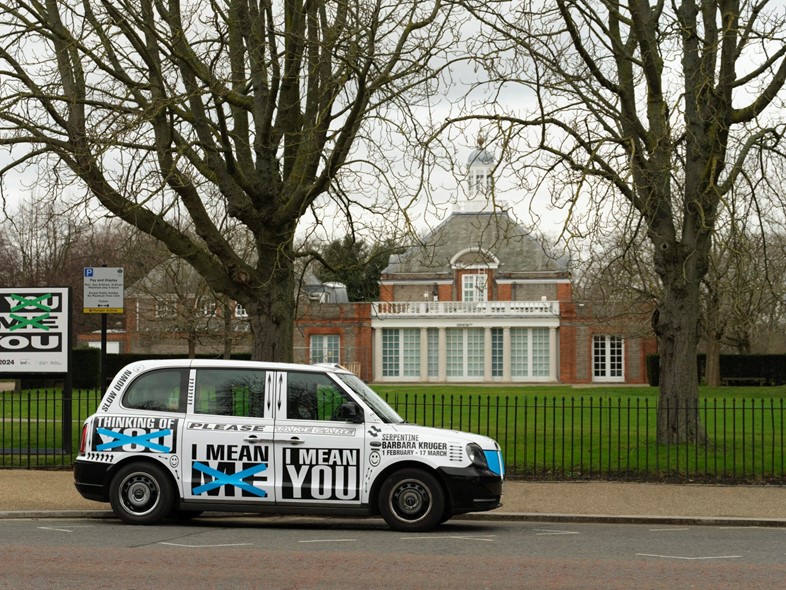
“What a ridiculous clusterfuck of totally uncool jokers.”
Despite her loathing for fantasy-fuelled consumer culture, Kruger’s work is so immediately recognisable it’s become a kind of brand in itself. By adopting the visual language of advertising in order to parody and critique consumerism, her work has, like some sort of reflexive mirror game, been appropriated by brands as a signifier of cool.
Skatewear label, Supreme, unashamedly used Kruger’s signature white-on-red Futura Bold Italic text. Yet, in 2013, in a bizarre act of erasure or delusion, Supreme filed a lawsuit against Leah McSweeney’s Married to the Mob (MTTM), a women's street clothing brand who used the Supreme logo to make "Supreme Bitch" t-shirts and hats. When asked by a newspaper to respond to the situation, Kruger famously sent a blank email with an attachment called fools.doc, which contained the statement: “What a ridiculous clusterfuck of totally uncool jokers. I make my work about this kind of sadly foolish farce. I’m waiting for all of them to sue me for copyright infringement.”
In 2017, Kruger reciprocated by staging the next act of this postmodern story with Untitled (The Drop), as part of the 2017 Performa Biennial. This visual performance piece involved stocking a pop-up shop in New York’s SoHo with items mimicking Supreme’s brand box logo re-repurposed for her own ends – clothes declaring “WANT IT, BUY IT, FORGET IT” and a skateboard bearing the slogan with “DON’T BE A JERK”.
Barbara Kruger: Thinking of You. I Mean Me. I Mean You. is running at Serpentine South Gallery from February 1 until March 17, 2024.
Join Dazed Club and be part of our world! You get exclusive access to events, parties, festivals and our editors, as well as a free subscription to Dazed for a year. Join for £5/month today.
